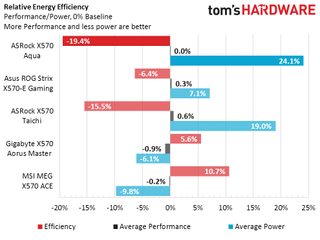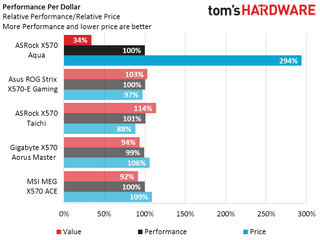ASRock X570 Aqua Review: Feature-Packed, Liquid-Cooled
Why you can trust Tom's Hardware
Benchmark Results and Final Analysis
Gigabyte’s GeForce RTX 2070 Gaming OC 8G and AMD’s Ryzen 7 3700X update the hardware configuration of our most-recent X470 test system, while a newly configured test suite brings all the compatibility benefits of Microsoft’s latest Win10 patches.
Benchmark Results
We start our benchmarks with synthetics in hopes of determining any performance anomalies in individual components, but the only thing that stands out in the charts is a miniscule advantage in PCMark Productivity.











Moving through the test, we also find that the X570 Aqua bumped our Cinebench results up a level, but dropped to last place in MP3 and H.264 encoding. The board’s overall performance is dead-on average.
Power, Heat and Efficiency

We found that the alternative cooling configuration needed to connect the X570 Aqua’s monoblock consumed an extra eight to 10 watts, so we deducted 10W from the readings when comparing systems that used the less power-hungry closed-loop cooler. Even then, the extra components of the X570 Aqua required extra power.

As we’ve seen in the past, the cooling advantage of this monoblock is limited to components other than the CPU. We use the highest continuous reading in these charts, and while the uncooled chokes of the other boards ran far hotter than the MOSFETs, both of these component groups are addressed by the X570 Aqua’s monoblock.

The X570 Aqua consumes a great amount of power at stock settings, and the only thing keeping these results from looking even worse is that the previous ASRock board had already dragged down the efficiency average. So if power consumption is key for you, you may want to avoid ASRock altogether in your X570 build.
Final Thoughts
We first show a value chart that cheapskates can use to make fun of big spenders, in that it doesn’t address the value of any added features.

With that out of the way, we can’t think of any reason for a motherboard like the X570 Aqua to cost more than $500, sans monblock. Meanwhile, Bitspower is selling monblocks for other boards for around $200. So anyone who buys the X570 Aqua is paying for something in addition to the motherboard and monoblock. Perhaps it’s the fancier trim that covers much of the monoblock’s surface? Or perhaps they’re merely paying for exclusivity, with ASRock labelling each production board as one of 999. That would be 999, plus ours, plus whatever other review sites got one, plus whatever units the company is keeping on hand for firmware development, memory validation, and so forth. If you’re one of those people who likes to pay for exclusivity, we won’t stand in your way.
The X570 Aqua is a nice board apart from its price and its PCIe 2.0-connected parts, the latter of which probably isn’t a concern to a target market full of extreme enthusiasts. The board keeps its voltage regulator and PCH nicely cooled with only the noise of the liquid cooling system the user chooses to install. It has the full Thunderbolt 3 experience built in, it counts 10GbE among its dual networking, and tops that off with a Wi-Fi 6 controller. The speedy networking and Thunderbolt additions likely add quite a bit to the board’s asking price as well.
In terms of missing features, the only things we would really ask for is an updated RGB app and a few more LEDs around the monblock's main window and outlet port. It’s not that all of us are big fans of RGB, but if you’re going all-in on a $1,000 motherboard, you might as well go all-out on the lighting so you can see what you spent your money on, right?
Image Credits: Tom's Hardware
MORE: Best Motherboards
MORE: How To Choose A Motherboard
MORE: All Motherboard Content
Current page: Benchmark Results and Final Analysis
Prev Page Firmware, Software and OverclockingStay on the Cutting Edge
Join the experts who read Tom's Hardware for the inside track on enthusiast PC tech news — and have for over 25 years. We'll send breaking news and in-depth reviews of CPUs, GPUs, AI, maker hardware and more straight to your inbox.
